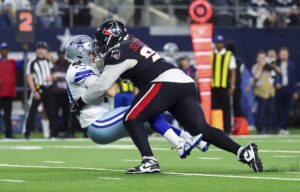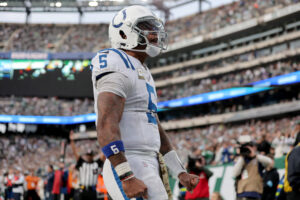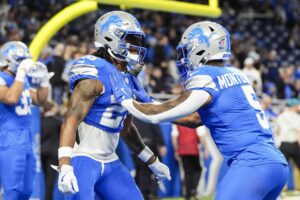Football is won and lost at the source of power; the line of scrimmage. No matter how schemes, players, and philosophy in football changes, the line of scrimmage will never change. The offensive line is the age-old position that receives no glory, but has made all-stars out of quarterbacks. The offensive line must be nasty, gritty, and resilient – and in 2017 it will set the tone for the Kansas City Chiefs. The door to a championship is open for the Chiefs, and to enter that door the offensive lline must take on principles of grit and resilience.
Welcome to the beginning of a series here on the Kansas City Chiefs section of Last Word on Sports. Over the upcoming weeks, the department will be doing a weekly segment breaking down the different positional groups of the Chiefs, and what it will take from that group for the team to win. Football is won as a whole, but of that whole, each segment must do their job to a certain degree to support the other positions. Want the Chiefs to take hold of the Lombardi Trophy this year? Here is what it will take.
Kansas City Chiefs Offensive Line: Resilience and Grit Keys to Success in 2017
A Lack of Resilience
Take a moment, and a deep breath, grit your teeth and remember the end of the Pittsburgh Steelers AFC Divisional Playoff loss. The final score was 18-16, and ultimately the reason the Chiefs lost the game was a lack of resilience in several moments. The game could have been won with one field goal; a score on an earlier drive. It is hard to admit, but the offense was not resilient in 2016.
Take a step back to the beginning of the 2016 season – it can be argued this is where team philosophy and mentality begins. Playoff teams prepare like playoff teams in training camp, and rebuilding teams prepare like rebuilding teams. At the risk of delving into abstract psychology, this is a self-fulfilling prophecy. It is very hard to trick your own brain from where you subconsciously know you are.
Applying this to training camp 2016, the Chiefs offensive line was a unit still coming together. Yes, they were preparing like a playoff team holistically, but the offensive line was still trying to gel as a unit. The final questions were being answered, and no team can be taught resilience before they are taught cohesion. By the time the 2017 playoffs had rolled around, the offense was functioning with regards to the playbook, no with regards psychologically.
Training Camp 2017
Extrapolate those principles forward. The Chiefs enter the 2017 training camp bitter, and mad. They were on the verge of victory, and every person in that organization needs to be prepared to give it their all to win. (Check out last week’s article about Alex Smith that speaks to this.) Training camp 2017 must speak to three principles – resilience, grit, and nastiness. And as stated in the opening, this begins with the offensive line.
If you have ever been to a football practice, recall where the intensity is set from – the line of scrimmage. That battle upfront can change the tone of a practice because they yell the most, fight the most, and push each the most. Think about the way a football play is set up and where everyone is looking – in front of them at the line of scrimmage. Their work ethic, their grit inspires running backs, receivers, or conversely corners and line backers, to fight harder and step up the intensity.
The Individuals
2017 is going to be a time for the Chiefs offensive line to be a cohesive unit, fighting to set the tone for the Chiefs passing and running game. The more time spent playing together, the more value that familiarity adds to each player. And it all begins with Center Mitch Morse.
The core of the offensive line is the center. Mitch Morse is the leader of the line, and now has experience setting up and reading plays with Alex Smith. As Morse goes, so goes the line. Ever notice Morse calling things out pre-play? That is the him setting up the play and calling out blitzes. Developing that takes experience, and having a player like Morse in big moments could be the difference between a blitz pick-up or a misread leading to a sack.
Eric Fisher is going to be corner stone. He may not be the overt leader, but his play is essential to the Chiefs over the length of a game. Blocking the blind-side builds endurance over the length of a drive. Fisher needs to do so in a legal way and cut down on back-breaking penalties.
Flip over to the other tackle – Mitchell Schwartz. Coming back for a second year, Schwartz now has the opportunity to become the cornerstone for sweep plays. Often missed is the communication between a running back and the pulling offensive lineman. Watch for key blocks on pulls from Schwartz, springing Ware on the right side.
Do not forget the interior. Standing up and blocking the guy in front of you is all it seems like – but in reality it is as complex as any other position with reads, pulls, and changing play calls. Parker Ehinger will secure the left guard position hoping to come back from an ACL injury. Ehinger doesn’t need to focus on being spectacular, just average. Coming back from a major injury like his is as tough mentally as physically. Enhinger needs to show confidence in his knees on pulls first.
Laurent Duvernay-Tardif, one of the biggest surprises for the Chiefs last year, will secure the right guard slot for years to come. He was signed to a $41.25 million-dollar extension over five years. After learning for four years, Duvernay-Tardif will make the Pro Bowl. No, he needs to make the Pro Bowl and not only secure the interior, but become invisible.
Production
There will be three production stats that will define the Chiefs offense in 2017. And the first is the most tangible way to show resilience and grit: red-zone rush efficiency.
Using Sharp Football Stats, the 2016 Kansas City Chiefs ran 49 running plays in the red zone and had a successful rate of only 24 runs. They only ran for six touchdowns and an average of 2.2 yards per carry. The 2016 Chiefs were nicknamed the Kansas City Field Goals for a reason; they could not finish running in the red zone.
The 2017 Chiefs need to eclipse a 55 percent success rate and score 11 touchdowns rushing in the red zone, all while pulling yards per carry above 2.6. Efficiency such as this would put the Chiefs in the top six in the NFL for red zone running efficiency.
Once again using Sharp Football Stats, we can see the 2016 Chiefs directional rushing success rate. Pass protection and red-zone efficiency show overall improvement in cohesion, and this stat is intended to look a bit more at individual production. The clearest observation is the Chiefs love running behind the center. They did it 161 times last year for 608 yards. Running behind either guard is also important, but due to the boom or bust nature of those plays, their average of 50 percent success is acceptable for now.
Where they need to improve the most is running to the right side and behind their tackles. Sweep plays to the right were seen 45 times, but only amassed 164 yards with a 49 percent success rate. With Kareem Hunt and adding a year of experience to Mitchell Schwartz, production needs to be north of 200 yards and 55 percent success rate. Additionally, Eric Fisher must step up big time and add variety to the playbook. Only 22 runs were seen directly behind him. Committing to more variety of run styles is possible with Hunt adding variety to the skill set in the backfield.
The final stat – quarterback sacks. Alex Smith was sacked 32 times last year and was hit only 68 times. Keep that up. Alex Smith can get rid of the ball quick, and the line can give him protection. Their pass blocking is among the best in the league.






